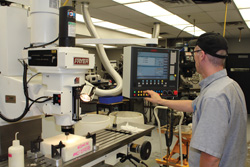Contributed by Aaron Hilkemann, President & CEO
Technology has created some of the most significant changes in our business over the last 25 years.
Today, Duncan Aviation team members access parts catalogs and manuals online from wireless computers throughout our hangars. Work instructions are completed and signed off by team members simply by scanning their badges. Customers can approve squawks online from anywhere in the world by accessing their secure myDuncan account. They can also obtain repair alternatives and view photos of squawks found without being onsite during the inspection. In addition to reducing paperwork, these technologies have enabled our workflow to be more efficient as customers approve items in a timelier manner and have access to a running total of additional approved costs.
Technology has also impacted repair procedures and allowed for better identification of cracks and corrosion through the use of digital boroscopes and NDT equipment. Improvements to equipment such as tugs, power carts and lifts have enabled team members to operate more reliable equipment that is also easier and safer to use. Improved fall protection, new LED lighting and more efficient heating systems have also helped to create a safer and more comfortable hangar environment for team members and customers.
Through the use of technology, we use safer and more environmentally friendly products throughout all of our shops, including not only cleaners and solvents, but an entire new system of chrome-free paint products used by our paint shop technicians. By using these more environmentally friendly paint products, we have been able to decrease risk to our workforce while increasing the number and size of aircraft painted in any one location while meet all EPA-induced environmental standards.
Technology improvements in engine, avionics and cabin management have improved the performance and, in most cases, decreased the operating costs to maintain the equipment. Consequently, the labor and parts supplied by MROs in these areas have decreased, along with fewer unscheduled maintenance events for operators.
Lastly, the emergence of the large and ultra large business jets has ‘shrunk’ our previously built hangars, causing the MRO industry to build new and much larger hangars. The planes considered ‘big iron’ 25 years ago are now considered mid-size aircraft. These large and ultra-large business aircraft have expanded the worldwide fleet and have created the perfect business tool for the new worldwide economy that has emerged. The other development that has put a demand on hangar space for MROs is the addition of winglets on aircraft of all sizes. Winglets, while making the aircraft more efficient, make stacking the MRO hangar more complicated.
Future developments that will impact the MRO industry include regulation and the continued growth and emergence of the worldwide fleet.
New regulations and interpretations of existing regulations have significantly impacted our business during the past 25 years. Many repairs for corrosion in the past were quickly resolved and signed off using 337s. Today, even many smaller inspections generate corrosion repairs that must be accompanied by engineering drawings that significantly increase the cost and timeliness of the repairs.
While the FAA continues to focus on streamlining regulation, EASA appears to be focusing on writing new and more complex regulations. The result of both actions by the FAA and EASA will continue to increase costs to MROs that will be passed on to operators. The FAA's focus on establishing delegated authority for MROs has resulted in increased MRO staffing to support the delegated authority and this is expected to continue. EASA's certification charges continue to be significant along with the additional costs to prepare the documentation required to obtain the certifications. While safety remains an important issue for operators and MROs, it appears the operating costs to maintain and certify new equipment and repairs are growing exponentially in relation to the improved safety of these new regulations and certification requirements.
The emergence of significant deliveries of aircraft worldwide during the past 25 years has created the need for MRO service providers throughout the world. The MRO industry will continue to build new facilities to service these aircraft and it will continue to be challenged to identify skilled workers to serve these markets outside of the U.S. While many international operators will continue to return to the U.S. for service, there will be a need for skilled workers to maintain these aircraft on a daily basis throughout the world. The MRO industry will need to continue to be innovative to help these operators operate and maintain their aircraft throughout the world.
Our industry remains in a strong position to facilitate business growth and expansion throughout the world. Based on the significant deliveries during the past 25 years, it is hard not to be optimistic about the next 25 years of business aviation.


